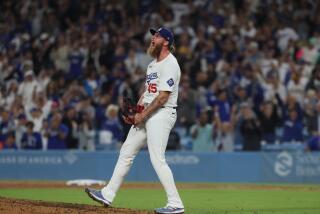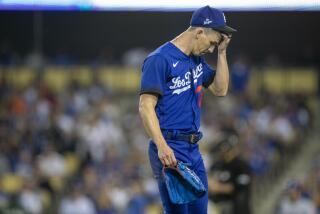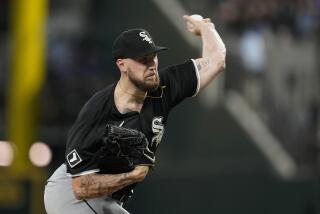The pitch: No more blisters
Dodger head trainer Stan Johnston has spent half his life in his kitchen, concocting a remedy to prevent and treat blisters.
His latest potion contains 12 secret ingredients, smells like an old-fashioned medicine cabinet, looks like thick teriyaki sauce -- and pitchers love it.
For the record:
12:00 a.m. Oct. 9, 2003 For The Record
Los Angeles Times Thursday October 09, 2003 Home Edition Main News Part A Page 2 National Desk 0 inches; 29 words Type of Material: Correction
Blisters remedy -- An article in Monday’s Health section referred to a blister remedy used in the Army as tincture of benzine. It should have said tincture of benzoin.
For The Record
Los Angeles Times Monday October 13, 2003 Home Edition Health Part F Page 8 Features Desk 0 inches; 30 words Type of Material: Correction
Blisters remedy -- A story in last Monday’s Health section referred to a blister remedy used in the Army as tincture of benzine. It should have said tincture of benzoin.
The Dodger season may be over, but Johnston’s blister remedy is still at work. After years of tinkering with his blister cream and trying it out on various, highly paid guinea pigs, such as former L.A. pitcher Ismael Valdes, Johnston’s remedy has taken off this year among major league pitchers. Gymnasts, hockey and football players, even construction workers have ordered it. Johnston recently applied for a patent and hopes to partner with a drug company in his quest to take his ointment to the masses.
“I’m very serious about this,” says Johnston, a quiet man who calls himself an inventor at heart. “We’d like to go through the Food and Drug Administration and get it approved and put it on the open market.”
The product is called Stan’s Rodeo Ointment -- and the rodeo is where the story begins.
Johnston grew up on a ranch in Montana and spent his summers riding horses, roping calves and learning various rodeo tricks. In 1977, he began a professional rodeo career, but he continually fought blisters from holding the ropes.
“I wanted to figure out a way to heal quickly so I could ride again the next day,” he says. “I just started mixing things.”
Although sports medicine experts today can surgically repair and speed the healing of many devastating injuries, simple blisters continue to stump even the top gurus.
“Blisters are the bane of my existence,” says Dr. Bill Roberts, a family physician specializing in sports medicine at the University of Minnesota who just completed a blister-treatment manual for the university’s trainers. “The first thing is don’t do any harm. Blisters will take care of themselves if you take away whatever is causing the friction. But if you’re going to continue to compete, you have to have something to deal with the friction.”
Blisters form when skin rubs against another surface. The upper layers of the skin tear away from the layer below, then fluid creeps in between the torn layers.
Blisters are a common problem for pitchers because pitchers need to grip the seams of a baseball firmly and throw it 80 to 100 times a game, usually every five days. Blisters on the feet can be slicked with an ointment, such as petroleum jelly, and taped or covered with layers of socks, allowing an athlete to continue to perform. Pitchers have no such options, much to the consternation of players, coaches and trainers.
Last season, three Atlanta pitchers developed blister problems at the same time. Recently, in the thick of the National League playoffs race, the Dodgers scratched pitcher Odalis Perez from one game because he broke a fingernail and was afraid of getting a blister. (He later pitched and did develop the dreaded blister, which he blamed on the missing nail, not on the failure of Stan’s Rodeo Ointment.)
Blisters pose so great a threat to pitchers that locker rooms are replete with stories about cures -- from folk remedies to superstitions to rumors. Part of baseball lore is the tale of flame-throwing former pitcher Nolan Ryan, who says he resolved his blister problem by soaking his fingers in pickle brine between starts. Other pitchers swirl their fingers in a bag of dry rice between games, which is supposed to toughen the skin. According to Roberts, another popular approach is to apply a roll-on antiperspirant containing aluminum chlorohydrate to the skin. And in the Army, he says, doctors used to cure blisters by draining them and then shooting them up with tincture of benzine. “It stung like crazy but took care of it.”
Johnston’s remedy works for both prevention and treatment, although he does have another product, Stan’s Blister Rub, that’s specifically for prevention. The purported rapid-healing properties of the blister ointment, however, seem to have impressed athletes the most. Word-of-mouth buzz is why Johnston thinks his remedy is suddenly in high demand. Johnston estimates that three-quarters of major league teams use Stan’s Rodeo Ointment.
“Probably the reason it has spread is that players move from team to team so much now,” he says. “They hear about a blister problem and say, ‘You know, Stan has this stuff....’ ”
Johnston, who has no compunction about sharing his ointment with other teams, had a high-profile success story this year in Florida Marlins pitcher Josh Beckett.
Beckett, who pitched last week in the playoffs, is a young, fastball-throwing future star whose career was hampered in 2001 and 2002 by blisters on the middle finger of his right hand. But this season, Beckett says, he began using Stan’s Rodeo Ointment. Problem solved.
The requests are pouring in at the Homelink National Pharmacy in Torrance, where Johnston’s remedy is compounded and sold by prescription only. The ointment doesn’t contain any prescription drugs -- which is why he can make it available without regulatory approval -- but as demand increased, Johnston opted to have a pharmacy make the complicated mixture. Homelink specializes in sports remedies and has helped Johnston promote the ointment to its clients.
Johnston would like to get FDA approval because the process would subject the product to rigorous studies. With the science to back it up, he’d be able to make published health claims.
“It’s definitely catching on,” says Robert Nickell, president of Homelink, which specializes in sports remedies. “When pitchers tell you, ‘I got to the playoffs because this stuff works,’ that’s big. The minor leaguers hear about it from the major league players. Then the college kids hear about it. Recently, the word is getting out to the public.”
Johnston, who attended school in sports medicine after his seven-year rodeo career ended, misses the days when he whipped up batches of ointment in his kitchen before games and on off-days. He estimates he tried more than 30 ingredients to come up with the final solution.
On one particularly memorable day, Johnston found an ingredient that congealed the liquid into an ointment, which meant he no longer had to microwave the stuff.
He’s mum on the ingredients of Stan’s Rodeo Ointment, which sells for $30.50 for a 2-ounce jar. Sports medicine experts have said that the product probably contains benzene and possibly Bag Balm, something ranchers use on cows with painful udders. It’s all safe and legal, Johnston says, even though it may sting a bit when applied to raw skin. He says the ointment also contains ingredients that heals cuts; many of the Dodgers ask for “Stan’s stuff” for all kinds of wounds.
Roberts thinks the concoction contains something that toughens the skin so that blisters don’t form as easily. Whatever is in it, he wishes Johnston luck. “If it really works it will catch on and be sold all over. He’ll make lots of money. And if he does, more power to him. They don’t pay trainers enough.”
More to Read
Go beyond the scoreboard
Get the latest on L.A.'s teams in the daily Sports Report newsletter.
You may occasionally receive promotional content from the Los Angeles Times.










